Itaparica, Part II
Cruising notes given in good faith, but not to be taken as gospel.Amigos, Gringos, e Muito Mais!
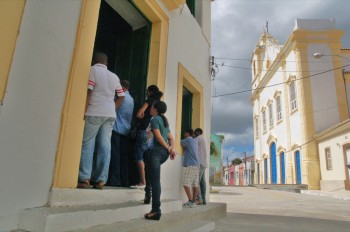
Besides providing a snug, safe anchorage and access to a great sailing playground, Itaparica also boasts various other facilities of relevance to the visiting yachtsmen, and not the least of these is the bar which, effectively, functions as an international yacht club.
Amigos BBQ was founded some three or four years ago by Willem and Robyn der Merwe, a South African couple who arrived here in their yacht and liked the place too much to want to move on. Since Brazilian law forbids the importation of any but brand new craft, the boat had to go. With the money from the sale Willem and Robyn bought a house whose backyard trailed down towards the waterfront, and in the yard they have crafted a pleasant walled garden, and built a barbecue and a restaurant.
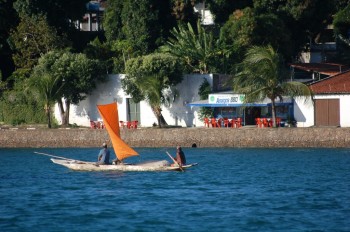
Amigos is popular both with the locals and with visiting yotties, who tend to use it as a place to meet up and share a few beers. As a service to the community of which they were once fully paid up members, Willem and Robyn also provide a free wifi connection which is accessible from the anchorage.
You will spot Amigos from your boat. It’s the place with the blue awnings and the red chairs placed outside on the pavement.
Not long after our South African friends had set up shop, Robyn’s daughter, Natalie, came to visit them, and she didn’t so much fall in love with the island as with one of the locals. Natalie and her husband, Daniel, now run a pousada (or bed-and-breakfast) which is situated just a stone’s throw from the Amigos but with its back to the sea.

Pousada Muito Mais doesn’t just provide accommodation. As the name suggests, it has “much more” to offer. You can come for a coffee; you can use the internet facilities; and you can have breakfast sitting in the open and airy living room, looking out over a wonderful, wilderness garden. You are quite likely, while you sit here, to glimpse squirrel-sized tamarin monkeys scampering about amongst the trees. Indeed, if you get here early enough you can all but shake hands with these little “saguines”, because every morning they come to the balcony to collect their daily ration of bananas and mangoes.
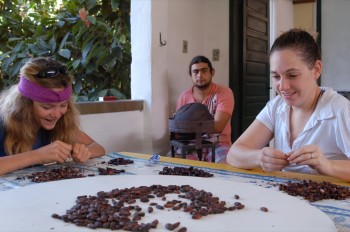
Many of the trees in Daniel and Natalie’s garden are cocoas. In the past the pods sprouting from the branches used to fall on the ground and go to waste. With an eye to making use of them, Daniel decided to try his hand at making 100% organic chocolate. Various wonderfully rustic machines were bought or created, and the couple invested much time in discovering how to roast, peel, and grind the bitter beans and make them into something delicious. Eventually they had a product which was so good it was saleable – and they now sell it not only to their guests and to passing yotties but also to a shop on the mainland.
Word of Itaparica’s benefits also reached Willem’s side of the family, and just a few months ago his son arrived and set up business a couple of hundred yards along the road from Amigos. The new bar-come-pizzeria is called Gringos.
All in all, the family seem to be establishing a dynasty here!
Passenger of the Wind
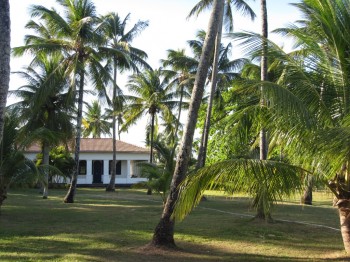
On the far side of town Itaparica disintergrates into a network of grassy lanes. The buildings in this vicinity are a mixture of half-finished breize-block houses and gringo-style mansionettes, and each one stands isolated on its own plot amongst the grickle grass and undergrowth. Right on the edge of the sea, with the tide pretty much lapping at the lawn, there is an arts centre of sorts, where creative people of many nations and many disciplines find refuge from the world. Here, at Sacatar, they can immerse themselves in their work. There are few distractions in this uncluttered space. They don’t have to cook; they don’t have to clean; they don’t have to do anything except paint, draw, write, sculpt, or otherwise give vent to their creative urges.
Barely a hundred yards along the lane from Sacatar one finds a rather different sort of retreat. Here stands the abode of a lone artist and globe-trotting yotty who washed up here some 20 years ago. A Frenchman, our friends have told us, and a wonderful cook. He has only one eye; he lost the other when some drug-crazed burglar shot him in the face.
We round the corner where the house is built and find ourselves in a green lane which trails towards a surf-shack bar and the blue-green sea. The Frenchman’s home is tucked behind a tall white-painted wall and hidden amonsgt the crowding palm trees, but a small arched doorway leads, like a mousehole, through the wall. Beside it are painted three doves and the words, Pousada Passageiro do Vento. The literal translation is Passenger of the Wind.
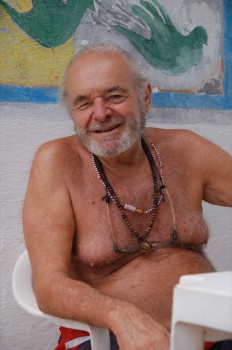
Serge Ungaro is sitting in the shack at the far end of the lane, quaffing a beer, but on spotting four females on the threshold of his den he rises, still with his galss in hand. He comes rolling towards us – a small man with a smile on his face and, one senses, an even bigger smile in his heart. The air around him seems to positively buzz with quiet geniality.
“May we look inside?”, asks my Canadian friend.
“Mais bien sur,” Serge smiles genially back at her.
We enter through the mousehole and walk straight into the mind of the artist. On our left there is a shrine-like fountain. Tucked away in a corner, to our right, is a tiled alcove a little like a public shower, but it is occupied by a collection of African-style wood carvings – and an anchor. Closeby, under the edge of a sloping tiled roof, stands an antique table cluttered with statuettes of the local sea-godess, Iemanja. On our right, nestling under a low, tiled roof is a kitchen, and beside us, poised in that no-mans-land between indoors and outdoors, is another old dining room table. This one is lit by a chandelier of tarnished Christmas baubles.
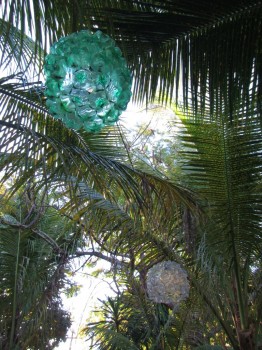
Ahead of us, on the far side of the shell-strewn courtyard, a woman sits washing her hair. Her plaster-white form is besmirched and softened by green and brown algae and her head is crowned by a pile of fallen leaves which she wears like matted hair. Rustic carvings of Iemanja, the mermaid, hang on various walls. Poker-faced African-style gods glower at one another across the cluttered space. A tired and ancient doll; a turtle’s skull; a glass jar packed with tiny pink shells; a row of rustic and rusty oil lamps; seven coal-fired smoothing irons; two huge whale’s vertebrae; another skull… Every table, every wall… every surface within this mind holds its own treasure.
Responding to our enthusiasm, Serge took us across the lane and showed us his garden – The Garden of the Oreixas (the Afro-Brazilian Candomble gods). This green place is his open-air studio.
We mentioned the nearby arts centre. “Ah, yes,” said Serge with a smile. “There you have the American romance. Very hygenic. Here you have the French romance.”
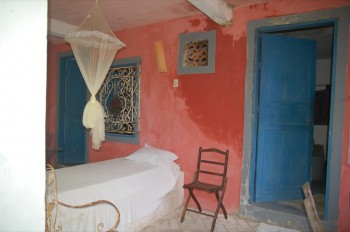
Besides being his own retreat, Serge’s abode is also open to passing back-packers and to any whose heart and mind are open to the creative. The guest rooms are simply furnished and are decorated with further works of art by Serge. This particular locale is not the most secure… although Serge boasts that since his little run in with the drug-traffickers, ten years, ago, he has been left in peace. “A man who is still alive after he was shot in the head…! They fear that I am some kind of god!” Still, this probably isn’t the place to stay if you travel with heirlooms and iPhones in your Louis Vuitton luggage.
A night at Pasageiro do Vento costs 50 Reais each or 60 for a couple.
A three course meal cooked, to order, by Serge is 35 Reais per person.
Other facilities and attractions in Itaparica
The Bica
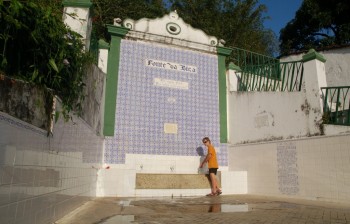
Bica (“beaker”) means spring, but this name is given not just to the village pump but to the place where it is to be found. In Joao Pessoa an entire park, complete with pond and zoo, is known as the bica. In Itaparica the name is given to the little praça where the fountain bubbles forth.
Of course, Itaparica now boasts a modern plumbing system, with every house linked to the mains in the usual way, but the water from the spring is so good that even the locals still come to the bica and collect it, in plastic bottles. A notice on the tiled wall beside the fountain says that old women who drink these waters will soon feel like their daughters.
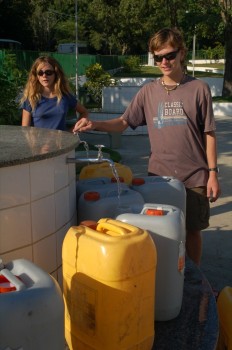
There are actually three taps set into the wall, and tradition says that if you want to enjoy the full effect you need to drink from each one in turn, as each provides a different elixir – but in reality they all come from the same source.
If you’re not fussed about tradition and such like, you can fill your jerrycans at the newer installation, on the seaward side of the praca.
Incidentally, the water in the marina comes from the same spring but it has travelled along plastic pipes. It is said to taste nowhere near so good; and you have to pay for it!
Drying Out
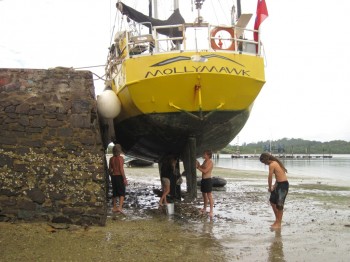 With a tidal range of around two metres, Brazil ought to offer plenty of opportunities for yotties to dry out and scrub off. All that is needed is a robust wall or jetty with a patch of hard, level ground alongside. Strange to say, there are surprisingly few such places to be found – but there is one in Itaparica. It consists of an old stone quay in the vicinity of the bica. In former times the saveiros (local trading craft) used to lie alongside while they took on a cargo of bottled water, but – for whatever reason – this business folded; bottled water now comes all the way from Rio de Janeiro, and the quay is abandoned.
With a tidal range of around two metres, Brazil ought to offer plenty of opportunities for yotties to dry out and scrub off. All that is needed is a robust wall or jetty with a patch of hard, level ground alongside. Strange to say, there are surprisingly few such places to be found – but there is one in Itaparica. It consists of an old stone quay in the vicinity of the bica. In former times the saveiros (local trading craft) used to lie alongside while they took on a cargo of bottled water, but – for whatever reason – this business folded; bottled water now comes all the way from Rio de Janeiro, and the quay is abandoned.
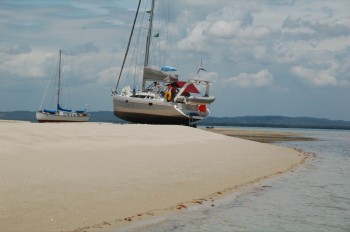
If you want lean on the quay and work on your boat you should first speak to the caretaker, who lives in the house inside the compound. In the past there was no fee, but nowadays one is required to pay 50 Reais per tide. No one seems quite sure whether the money goes to the owner of the quay or whether the caretaker is on the make… (We offered 100 Reais for 6 tides and it was accepted.)
If your boat is a centreboarder or a multi-hull then you have no need of the quay; you can dry out on the sand bar. At springs you will have around eight hours in which to complete your work.
Shopping
There is no vegetable market in Itaparica, but there are various small supermarkets whose stock varies in quality according to when the last delivery was made. There are also two dedicated fruit and veg stalls – one on the lower, main road, about a quarter of a mile to the right of the marina and the bica; the other at the far end of the upper road, which leads from opposite the pousada.
There are various bakeries, all of which sell the usual white fluff which, in this part of the world, passes for bread. The one opposite the pousada also sells delicious little savoury biscuits. The heart-shaped ones are the most tasty – naturally!
The better supermarkets are also on the upper road, but if you want to do a big shop you might prefer to head across the island to Bom Despacho. Here there is a Bompreço hypermarket.
Bompreço carries a far wider variety of produce than the village shops, but it isn’t a lot cheaper – in fact, when you take into account the price of the taxi fare it might even be more expensive – and it belongs to Walmart, one of the biggest five corporations in the world. On the whole, I dislike giving money to the already-super-rich… so I tend to shop in Itaparica.
If you do want to go to Bom Despacho you can get there in a “collectivo” (usually a VW kombi, but sometimes a car). At the time of writing this costs 2 Reais. Unfortunately, when you want to come back again you will probably have so much shopping that you need to hire a taxi – and this generally costs 20 Reis.
Gas
We bought our gas from a bar on the lower, main road; the first bar that you come to when walking from the bica.
These people allowed us to borrow a bottle (from which we could to tip the gas) without even asking for a deposit. Be sure to express your gratitude by staying for a beer.
Laundry
There is no laundrette in Itaparica, but various people will offer to take in your dirty clothes. Many yotties give theirs to Marli, a lovely Brazilian lady who is married to an Australian.
Aussie-Ron is another one-time sailor who has slung out his hook for the last time and who – due to Brazil’s impossible customs legislation – has had to part with his boat.
Actually, I say that he has swallowed the hook, but in fact when I last saw Ron and Marli they were talking about buying a catamaran… so it could be that by the time you arrive in Itaparica there will be no laundry service! In the meantime, if you can’t be bothered to haul the water from the bica and boil kettles, and so forth, treat yourself: call Marli on +55 71 3631 1902 or contact her by e-mail : conceicao_marli AT hotmail.com
At the time of writing Marli charges 20 Reais for a 6kg load (which is about as much as you can cram tightly into one of those reusable supermarket shopping bags).
Eating ashore
Besides Amigos, there are various other small bars and restaurants in Itaparica. At the weekend and during the busy Christmas season you can also buy food on the street.
In the mornings you can take your breakfast under a small gazebo just behind the marina office, eating traditional “mingau” (a sloppy porridge) of various kinds. It helps if you have a sweet tooth…
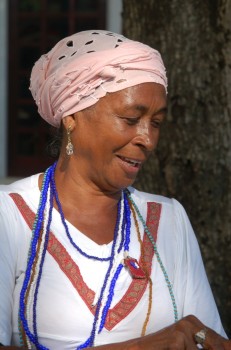
To sample the local, Bahian fast food, go to the old praça near the church at lunchtime and watch Anna frying acarajé. This is a dumpling made from bean flour and deep fried in “dendé” (palm oil). The cooked acarajes are split and filled, as the customer desires, with chilli sauce, okra, diced tomatoes, and smoked prawns.
Be warned: the Bahians do understand about hot food. Don’t ask for a bigger smear of that chilli sauce until you’ve tasted it.
Having eaten your fill of acarajé you can then move across to the sorveteria where ice cream in a multitude of flavours is sold by the kilo.
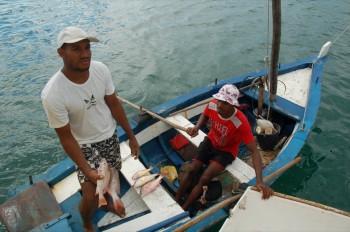
Just on the edge of the praça there is a fish shop whose cooked meals smell absolutely wonderful – even to a vegetarian.
Close by, as you head back towards the marina, you will pass the fish market where the locals sell their assorted catch of crabs, cockles, and miscellaneous fish. At the weekend you can also buy a rather nice curd cheese from one of the stalls.
Ferries
If you want to travel from Itaparica to Salvador (to clear in, for example) then you first need to get yourself to the other side of the island, either to Bom Despacho or to Mar Grande.
Bom Despacho
The ferries operating from Bom Despacho are relatively large affairs. Besides having enough space for a couple of hundred foot passengers, who rattle around inside the tin can of a raised cabin, they also carry twenty or thirty cars on their open lower deck. They are dirty and noisy, and rumour has it that one of them recently caught fire.
Travelling on one of these ferries costs about 4 Reais. The boats leave every hour, on the hour; the journey takes about an hour, as I recall it; and your destination is Comercio, an ill-favoured district a short bus ride from the old town.
This is the ferry to use if you want to visit the even dirtier, noisier, but rather exciting Sao Joaquim market, adjacent to the ferry terminal; and it’s the one to use if you will be travelling after dark (when the Mar Grande ferry stops running).
It’s also the one to use if your journey happens to coincide with low water springs.
Why?
Read on…
Mar Grande
The ferries operating from Mar Grande are relatively small (60ft – 80ft) wooden vessels known as lanchas. They bustle to and fro between the city and the island like fat water beetles, operating to the same kind of schedule as London buses. Sometimes you might wait for almost an hour for a ferry. Then three will arrive at the same moment.
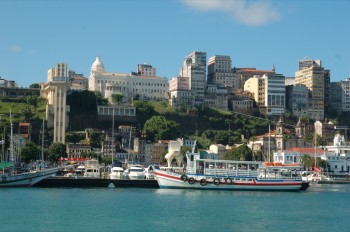
There are two good things about the Mar Grande ferries. Firstly, they take you right into the heart of the old town. From here, the various offices of the policia federal, the alfândega (or receita federal), and the port captain are but a short stroll. (They are in different directions, of course… Hey, this is Brazil!)
The second good thing about the Mar Grande ferries is that they are rather fun. You’re on a proper boat, with the water slooshing past just behind the bench you sit upon; you get a nice view of the moored ships and of the city as you approach it; and, best of all, you’re part of a throng of local men, women, and children who are going to enjoy this journey – just as they enjoy everything else in life.
Brazilians don’t know how to do anything without having fun and being happy, and their attitude is contagious.
Everything else about the Mar Grande ferry service is bad news.
Some folks claim to have been able to saunter aboard the ferryboat with no hassle, but whenever we have used them we have had to join a massively long, very unruly queue. We have never had to wait less than an hour and a half, standing in the hot sunshine, and we once had to wait two and a half hours.
On this latter occasion, growing anxious about the situation (and having observed dozens of people queue-jumping at the front of the throng) I went to investigate. I discovered that there were, in fact, two ferries waiting on the pier, but they were both hard aground.
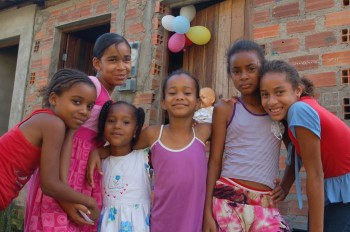
Bear this in mind, too, when returning from the city. Robyn (from Amigos) once found herself on a ferry which ran aground just a hundred yards from the jetty. She and her fellow sufferers had to wait two hours before the thing floated off, on the rising tide.
But, as I say, the Brazilians don’t actually suffer, they enjoy. The locals were probably perfectly happy to sit and wait. We Westerners are different. After 25 years of living without deadlines or schedules, I nevertheless still writhe in frustration at this sort of delay. Had it been me I think I would have had jumped overboard and swum the last little bit…
If you haven’t read the first part of this article, you can find it here.
